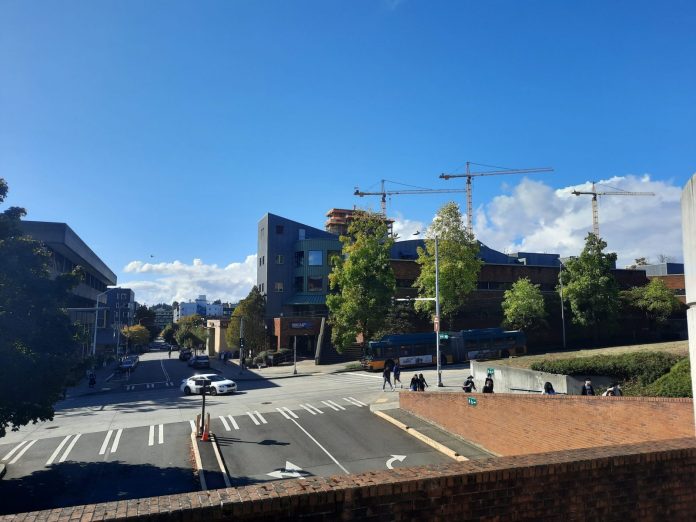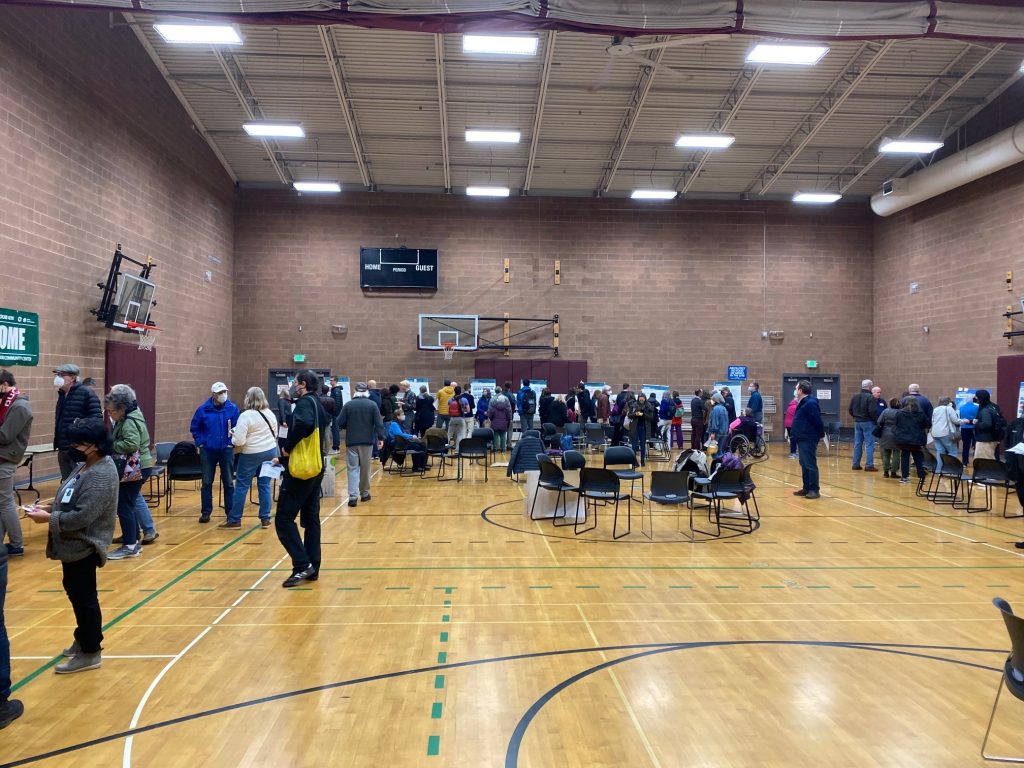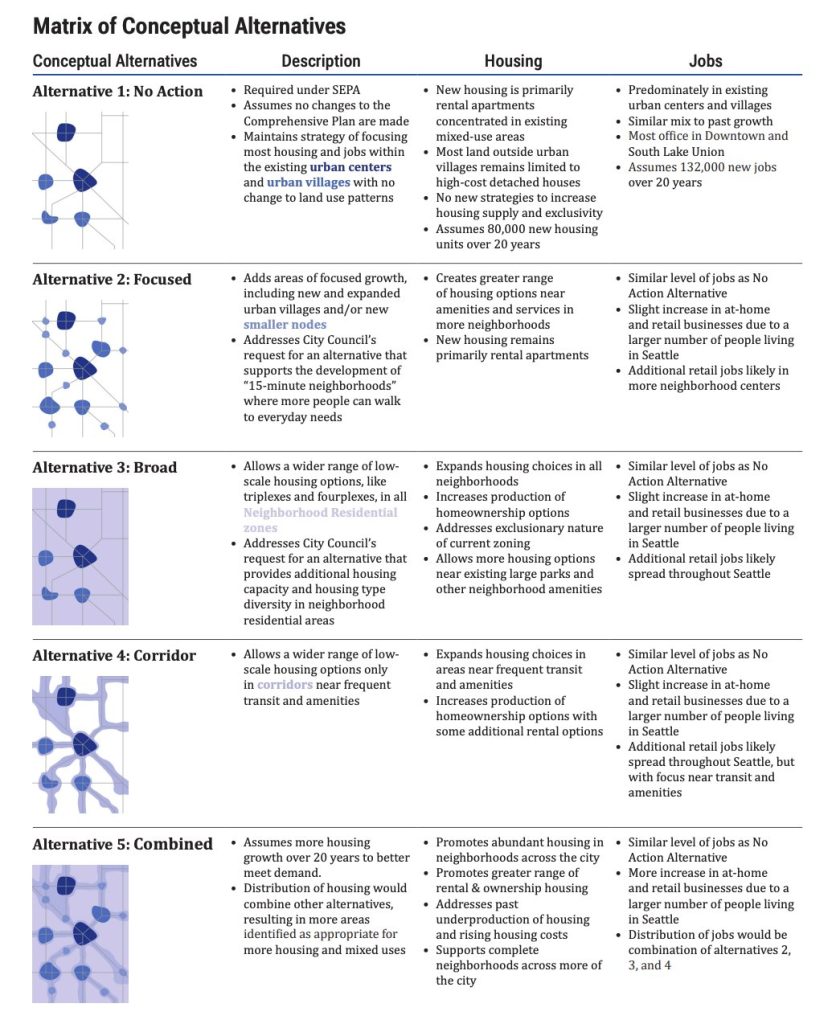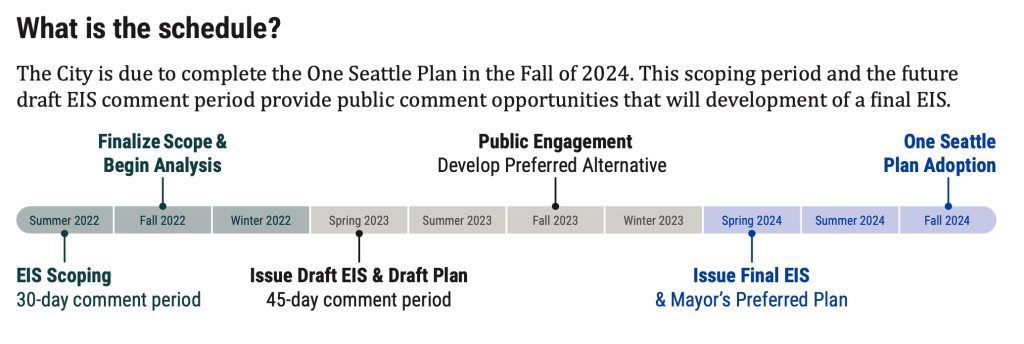
Seattle’s Office of Planning and Community Development (OPCD) has announced that release of the One Seattle Comprehensive Plan will be delayed until September. The Draft Environmental Impact Statement for the plan had been expected to be released this month – itself a delay from the City’s previous April 2023 target. The delay of this crucial step for the state-required planning document moves public comment input to the very busy fall.
The last time we checked in with the comp plan, it stunk. As all agencies developing a comprehensive plan are required to do, OPCD was required to develop an environmental impact statement (EIS) to assess the plan’s impacts. The first step was to “scope” the EIS, or set the boundaries of proposed alternatives and potential mitigation.
OPCD failed pretty spectacularly at that. The agency pushed out five potential alternatives for developing the next 20 years of housing in the city. Mostly just a mess of dots ranging from “add a few houses to the Urban Villages” to “stick them on the highways,” the alternatives were unserious political milquetoast. Even the most aggressive housing alternative that was proposed would leave Seattle tens of thousands of homes short for today, and in a much deeper deficit for future growth. At the same time, the city’s industrial lands component is running ahead of the overall comp plan, segregating the jobs from the houses needed to fill them.
And the Mayor’s Office got ahold of branding the comprehensive plan, labeling it with Harrell’s oft-repeated campaign moniker, One Seattle, even as the mayor seems to be fighting to shield neighborhoods from zoning changes and keep the preexisting “Two Seattles” zoning framework. One Seattle is also made a lie by the fact the aforementioned industrial lands plan plainly identifies that there are two separate comp plans.
The scoping report was met with a furor. Organizations and regular folks pleaded with City Hall to do better. It was very easy to read the alternatives as limits rather than goals or projections. Even the meetings didn’t have enough places for people. Folks including The Urbanist and Councilmembers Teresa Mosqueda and Tammy Morales asked for a sixth alternative, begging for a bolder plan that at least made an attempt at meeting the climate and housing challenges of the next 20 years.
After those comments were submitted in January, OPCD was required to take all the scoping submissions about what the plan should be, and develop a Draft EIS. During scoping, the draft was projected to be complete during the first half of 2023. The announcement last week was an admission it’s not ready.
“[T]he release date for the Draft One Seattle Plan and Draft Environmental Impact Statement (DEIS) has been rescheduled to early September 2023,” OPCD wrote in an email to stakeholders and press. “In the coming months, we will work on the Draft Plan to ensure we have thoroughly incorporated community input, to respond to new state requirements, and to prepare public engagement materials for this fall.”

Rescheduling the release for the draft EIS may be acceptable. For folks who are going to need to read it, getting a thousand pages of indigestible consultant-speak in the middle of summer deeply sucks. This is also a somewhat involved summer, as Seattle has a very crowded primary election is slated to narrow the potential occupants for seven council positions.
Of course, the autumn ain’t much better. The council returns and quickly moves into budget season. That’s why a lot of land use and policing bills have been on the council’s dockets now, to clear the decks for the other side of the summer. Giving City Council less time to chew on and amend the Mayor’s plan could also be part of the calculation here.
The general election will also be looming. The two at-large members of the council are not up for election, and four more are not seeking reelection. Meanwhile, citywide Councilmember Teresa Mosqueda is running for King County Council with a boatload of big endorsements – a Mosqueda win would rob council of a prominent skeptic of status quo zoning and an Alternative 6 advocate.
The string of retirements leaves three incumbents – Dan Strauss, Tammy Morales, and Andrew Lewis – actively campaigning should they make it through the primaries. The comprehensive plan is crucial for their districts – centered in Ballard, Southeast Seattle, and Downtown respectively – but very difficult to discuss on the campaign trail and not nearly a sexy as budget items. A cynical perspective would suggest the comp plan release is being purposefully buried in the fall.
Besides the end of terms for several council members, a shifted schedule will also bump up against the state’s imposed time limits. Seattle and all jurisdictions in King, Snohomish, Kitsap, and Pierce counties are in the first wave of plans due on December 31, 2024 by state law.
While a little over a year seems like plenty of time to get some paperwork done and a vote completed, it is not. The initial plan scheduled most of summer and fall of this year for public engagement to develop a preferred alternative. Now that will have to occur across the election cycle and the holidays. The Final EIS was due in spring 2024 with adoption in the fall 2024. Now those will be pushed back to be considered during yet another budget season and a presidential election. That brings the comp plan right up to the New Years Eve 2024 deadline.
Really, the future process of the comp plan depends on how much the draft gets right this fall. When the Draft EIS does emerge this September, the thousands of folks who submitted comments are going to expect to see their effort and concerns reflected in the document. All of those anxieties about climate. All of those pleas for housing. All of that begging to get it right. If those do not appear in the text of the document, making the final deadline and certainly meeting the moment could also be in jeopardy.
There will also be two other items to pay attention to when the Draft EIS emerges in September.
First, it’s going to be important to see how much the Draft EIS reflects on zoning and comprehensive planning’s roles in creating Seattle’s segregation. OPCD did a good job of including some of that text in the Maritime and Industrial EIS, stating “Seattle’s first zoning ordinance in 1923 and its major update in 1956 located multi-family residential districts at the edges of rail lines, industrial districts, and manufacturing districts. These land use decisions were racially motivated and caused harm to non-White households.”
The agency then went on to list some other decisions that accentuated racial inequality and discrimination. Now it’s time to land that plane, bringing this thread of segregation up through the Urban Villages that almost never touch water and continued squeeze of apartments onto polluting, dangerous arterials.
Second, the Draft EIS must address state legislation like HB 1110’s requirement to permit middle housing throughout the city. This is mentioned in the rescheduling announcement as “responding to new state requirements.” The barometer will be whether the new missing middle bill is incorporated as simply referenced or taken to heart. Public opinion polling has confirmed sixplexes are popular with Seattleites and a recent poll found four- to six-floor apartments geared at the working class are even more popular.
One of the EIS scoping alternatives proposed modest but “broad” housing increases throughout the city, allowing triplexes and quads in most neighborhoods and creating a map similar to what will be required HB 1110. As she discussed in The Urbanist Podcast, Rep. Jessica Bateman (D – Olympia) proposed these changes at the state level so zoning for middle housing does not need an individual EIS in every city. Seattle’s EIS will be an absolute failure if it doesn’t take that opportunity, and make “broad” rezoning the new baseline from which all comprehensive planning must start.
Of course, Seattle must go further. Simply waiting on homeowners to add duplexes across the city will be time consuming and doesn’t break down the barriers of decades of segregation. It will take a lot of explanation to inform most of Seattle as to why HB 1110 didn’t do all the work for us, why a legitimate comp plan alternative has to build a lot more of all housing types everywhere. And that will take a robust public outreach plan.
While it will not be an official part of September’s Draft EIS, the proposed public outreach to develop a preferred alternative may become the most crucial building block of the new comp plan. The concerns that brought many people to comment on the EIS scoping was that good ideas were left off the table for political expediency, and we were being railroaded into status quo.
Now, with a shorter timeline possibly truncating the amount and schedule of public outreach, railroading is a real issue. If the ticking December 31, 2024 deadline to get the comp plan finished is used as an excuse for less outreach or a push for advocates to simply give in, we will have a firm indication of OPCD and the Harrell administration’s seriousness in addressing hard questions of climate, affordability, and housing. September’s comprehensive plan DEIS and the public outreach that surrounds it will show whether this delay is just one more bit of Seattle Process run amok, or an actual turning point in Seattle’s move to the future.
Ray Dubicki is a stay-at-home dad and parent-on-call for taking care of general school and neighborhood tasks around Ballard. This lets him see how urbanism works (or doesn’t) during the hours most people are locked in their office. He is an attorney and urbanist by training, with soup-to-nuts planning experience from code enforcement to university development to writing zoning ordinances. He enjoys using PowerPoint, but only because it’s no longer a weekly obligation.




